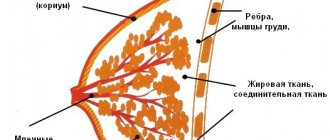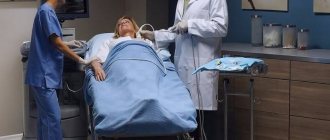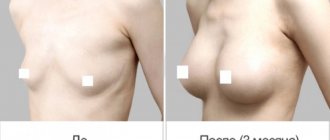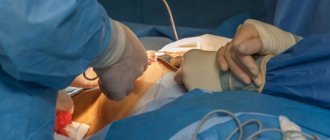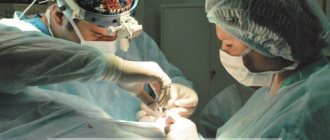Features of the operation
Mammoplasty through the areola has the following advantages:
- The method is characterized by a low probability of scar formation. The doctor dissects the tissue along the edge of the areola - in this area the skin is prone to rapid healing.
- Quickly achieve the expected result. This method of bust enlargement, such as periareolar placement of an implant, allows you to evaluate the effect already 4 weeks after the intervention.
- The breasts take on the most natural appearance possible.
Another advantage of surgical breast augmentation through the areola is the ability to quickly return to everyday activities.
Installing implants through the periareolar approach does not have any significant disadvantages.
What is submammary access?
The surgeon makes incisions (up to 4 cm) along the contour of the natural fold under the breast. Then, forming a pocket between the tissues of the mammary gland and pectoral muscle, a prosthesis of the required size is installed. Submammary access is suitable for installing any implants.
Advantages
- Good cosmetic effect;
- There is no risk of damage to the milk ducts;
- The doctor can install a prosthesis both under the pectoral muscle and under the gland;
- There are no restrictions on the shape and size of the implant.
Minuses
- Submammary access may be aesthetically unfavorable if the patient initially has poorly defined breast tissue and fatty tissue, and also has a tendency to develop keloid scars.
Who might suit it?
This type of access has successfully proven itself in world practice. It is safe for women, removes restrictions on the location of installation (under the mammary gland or under the muscle) and on the size of implants. Submammary mammoplasty is suitable for almost all patients.
Preparing for surgery
To enlarge the bust surgically, a woman needs to undergo an examination. Diagnostics include:
- Fluorography.
- Laboratory examination of blood (clinical, biochemical), urine. In addition to standard tests, coagulability, blood type and its Rh factor are determined; glucose level.
- ECG.
- Ultrasound of the mammary glands, determining the degree of their blood supply.
Before the operation, you need to consult an anesthesiologist. Additional types of diagnostics are prescribed on an individual basis. Taking into account the survey responses, it is determined that breast surgery will not have a negative impact on the woman’s body.
At the stage of preparation for surgical breast augmentation, the optimal type of endoprosthesis is selected. The patient’s body type and her expectations from the upcoming intervention are taken into account.
How is breast augmentation surgery performed through the areola?
Periareolar mammoplasty involves several stages:
- Performing anesthesia.
- Treating fabrics with an antiseptic solution.
- Skin incision, providing periareolar access.
- Implant placement.
- Layer-by-layer suturing of the surgical wound.
- Applying a sterile dressing.
- Removing the patient from anesthesia.
Throughout the entire period of intervention, the surgeon performs coagulation (cauterization) of the blood vessels, and the anesthesiologist monitors the woman’s condition.
Stories from our patients:
Yulia29.01.2021
Many thanks to the wonderful doctor Valery Grigorievich! I had rejuvenation surgery in 2021. Several years have passed, nothing has changed, only everything has gotten better! Especially the neck, you have no equal in this! There is no need to wait for quick rehabilitation and quick results! Everything will be great, but in a year... At least in my case, everything is individual! But, you are the best! I hope to meet you again, health permitting!
Read moreHide
Tatyana K.07/24/2020
Thank you very much, Valery Grigorievich! I am so glad that I chose you for my surgery. I look 20-25 years younger now (I'm 59). I myself did not expect to see such a young face. I am very happy. My husband is surprised that this could happen. He also really likes the result. Many thanks to everyone who helped you - Tatyana Alexandrovna and Anna Sergeevna. Many thanks to the anesthesiologists and nurses. The operation and recovery from anesthesia were very easy for me. Thanks to Alexandra, she has always been and remains in touch, thanks to cosmetologist Natalya Nikolaevna For women visiting the site and reading this review, I can add that the intervention was extensive: forehead endoscopy, SMAS, platysmoplasty and lower blepharoplasty. All this was done in 1 time - clearly, quickly, professionally. Therefore, there were no blue-black bruises at all. On the 3rd day, pale yellow bruises appeared under the eyes (already passing). There was no severe swelling. A week later, I calmly (wearing dark glasses) went out into the street. By now, 2 weeks have passed since the operation. The scarring process is completely painless, it is not visible from the outside. There remains a slight numbness of the chin, neck and forehead. But gradually sensitivity returns. You can feel it too. In general, the rehabilitation process is easy to bear, especially with such an emotional high from SUCH a stunning result.
Read moreHide
Tatyana K.07/17/2020
Thank you very much, Valery Grigorievich! I am so glad that I chose you for my surgery. I look 20-25 years younger now (at 59). I myself did not expect to see such a young face. I am very happy. My husband is surprised that this could happen. He also really likes the result. Many thanks to everyone who helped you - Tatyana Alexandrovna and Anna Sergeevna. Many thanks to the anesthesiologists and nurses. The operation and recovery from anesthesia were very easy for me. Thanks to Alexandra, she has always been and remains in touch. For those visiting the site and reading this review, I can add that the intervention was extensive: forehead endoscopy, SMAS, platysmaplasty and lower blepharoplasty. All this was done in 1 time - clearly, quickly, professionally. Therefore, there were no blue-black bruises at all. On the 3rd day, pale yellow bruises appeared under the eyes (already passing). There was no severe swelling. A week later, I calmly (wearing dark glasses) went out into the street. By now, 2 weeks have passed since the operation. The scarring process is completely painless, it is not visible from the outside. There remains a slight numbness of the chin, neck and forehead. But gradually sensitivity returns. You can feel it too. In general, the rehabilitation process is easy to bear, especially with such an emotional high from SUCH a stunning result. I don’t even want to wear makeup))
Read moreHide
Types of surgical access for breast augmentation and lifting
What is most interesting to patients who decide to undergo breast surgery? First of all, of course, future implants are their size and shape. An equally important question is “how will they be given to me?” and “will the seams be noticeable”?
The type of surgical approach for breast augmentation or lift is one of the main factors in the success of the operation, which largely determines its aesthetic result. ART-Clinic plastic surgeon, Candidate of Medical Sciences, surgeon of the highest category Vadim Sergeevich Bakov talks about the types, advantages and disadvantages of each of the possible approaches:
↑ Surgical access for augmentation mammoplasty
Today, all breast augmentation operations are performed using one of three main options:
Periareolar access. The incision is made along the lower edge of the areola, at the border of pigmented and unpainted skin, which allows the postoperative scar to become almost invisible after some time. The periareolar approach can be used to install any type of breast implant (anatomical or round) both under the muscle and under the mammary gland.
- When choosing this method, the surgeon has the opportunity to perform additional areoloplasty and mastopexy simultaneously with the enlargement. In addition, this approach allows the surgeon to simultaneously correct asymmetry or ptosis of the mammary glands.
- Disadvantages of the periareolar approach include the possibility of changes in nipple sensitivity. However, in the vast majority of cases, it is completely restored over time. If the operation is performed correctly, the mammary gland is not injured and the possibility of breastfeeding remains.
Axillary access. The incision is located in the armpit and runs along the posterior edge of the border of the pectoralis major muscle. Installing an implant through this access does not injure the mammary gland, since its tissues are not affected at all during the operation. In addition, this is the most cosmetic method, in which it is easiest to hide traces of surgery.
- The limitations of the method include its relative inconvenience when installing anatomical implants and increased requirements for the skill of the surgeon and the equipment of the clinic. At the Doctor Plastic clinic, this method is used ONLY with the use of endoscopic technology, since only in this case the axillary approach allows the atraumatic formation of a cavity for the implant, as well as control the risks and eliminate the slightest sources of possible bleeding.
- Serious contraindications for this method of implant installation are the presence of asymmetry of the mammary glands and the need to shift the inframammary fold.
The submammary approach involves an incision in the natural fold under the breast. In the case when the mammary gland and submammary fold are clearly formed and there is no need to displace it, the postoperative scar will be almost invisible.
- Advantages of the method: during mammoplasty, breast tissue is not affected, which completely eliminates their injury. This method is considered the simplest for the surgeon and safest for the patient.
- The only drawback is that such access is not recommended for patients with “girlish” breast shape. If there is no fold under the breast, the scar becomes noticeable. Therefore, we recommend this type of access only to patients whose breast structure allows them to obtain the most cosmetic result after plastic surgery.
It is worth remembering 3 more “exotic” types of surgical access for augmentation mammoplasty. Today they are practically not used due to the increased risk of postoperative complications or unjustified difficulties during the operation:
- Transareolar approach , in which the incision passes across the areola, bypassing the nipple along the lower edge. This type of access allows you to install teardrop-shaped and round implants under the pectoral muscle or mammary gland, but if the size of the areolas is not large enough, the incision may not be long enough. This option is the most traumatic for breast tissue, accompanied by frequent infectious complications and persistent loss of nipple sensitivity. At the same time, the method is characterized by high cosmetic value, since the postoperative suture is invisible on the pigmented skin of the areola.
- Transabdominal access is provided through an incision on the anterior abdominal wall along the bikini line. Breast tissue is not affected during the operation. Such augmentation mammoplasty is performed exclusively during abdominoplasty, as this gives surgeons the opportunity to perform two operations simultaneously through one incision. This is a rather complex option for breast augmentation, which is often accompanied by various complications due to the need to separate the subcutaneous layers over a large area and difficulties in creating a cavity for the implant.
- Umbilical access is provided by an incision in the upper semicircle of the navel. With this type of mammoplasty, the surgeon creates a long tunnel in the tissue through which breast implants are installed. This method is not currently used, because With its help, you can install only implants filled with saline solution, which are practically no longer used today.
↑ Surgical access for mastopexy (breast lift)
Breast lifting and asymmetry correction surgeries require skill and experience from a plastic surgeon. When performing this type of breast surgery, the choice of the type of surgical approach depends on many factors that influence the scope of the intervention: the severity of ptosis, asymmetry, the presence of excess skin, etc.
In the most “successful” option, to eliminate minor ptosis, it is enough to perform augmentation mammoplasty using implant models with a high projection profile.
More noticeable excess skin requires additional incisions to remove excess tissue and create harmonious breast proportions. If the natural volume of the mammary glands is sufficient, then during mastopexy only breast shape correction and subsequent aesthetic skin plastic surgery are performed. If the initial volume of the breast is insufficient, then during the operation an enlargement is performed with the installation of breast implants.
Severe asymmetry of the mammary glands, caused by a significant difference in their volume, is eliminated by partial resection of glandular tissue or installation of implants of various volumes.
The main types of mastopexy, depending on the type of surgical approach, include:
- Periareolar mastopexy. It is performed using two circular incisions: the first along the circumference of the areola, and the second at some distance from the first. Excess skin between the incisions is removed, their edges are joined, and the postoperative scar runs along the border of the areola and unpainted skin. Performed for small to moderate excess skin to correct ptosis and breast asymmetry. Scars with this type of lift become almost invisible 2-6 months after the operation.
- Vertical mastopexy. It is performed using circular incisions, supplemented by vertical ones, which are necessary to excise excess skin in the lower parts of the chest. This type of plastic surgery is used for severe ptosis of the mammary glands, since in this case, simply removing excess skin between circular incisions will not give the desired aesthetic effect - the breast will become flatter, and the outer edge of the incision will be noticeably “gathered.” An additional vertical incision allows you to remove excess skin in the lower parts and give the breast a natural teardrop shape. The incisions, of course, will be much more noticeable than the incisions around the areola, but modern suturing methods allow us to obtain a good aesthetic effect in this case as well. Thin and light vertical scars are not noticeable and do not spoil the overall positive aesthetic effect of the lift.
- To eliminate extreme degrees of breast ptosis, surgeons use additional horizontal incisions under the breast (in the submammary folds), which allows for the most natural result of the operation (this kind of lift is sometimes called an anchor breast lift). The additional scar under the breast is almost invisible after surgery, but it allows you to create a more beautiful and natural breast shape.
The choice of mastopexy method primarily depends on the aesthetic objectives of the operation and the patient’s goals, with preference, of course, being given to the type of surgical approach with minimal postoperative scars.
Rehabilitation
You should sleep on your back for a month from the date of surgery. Also, in the postoperative period, the patient needs to wear a compression bra - it helps the breasts maintain their natural shape. You should not shower until the stitches are removed. After removing the threads, a barely noticeable scar remains, which disappears on its own within 2-3 months. Often this does not require any additional measures.
See all photos
Patients and methods
The study included patients operated on from September 2015 to March 2021. Inclusion criteria were the presence of cysts of non-odontogenic origin (retention), the absence of clinical and radiological signs of chronic rhinosinusitis and deviated nasal septum, as well as neoplasms of the nasal cavity and nasopharynx.
Taking into account the specified criteria, 120 patients with the same complaints were selected. All patients were divided into 3 groups of 40 people each. Patients of the 1st group underwent extranasal maxillary sinusotomy; in patients of the 2nd group, cysts were removed using the endonasal method by widening the natural anastomosis with resection of the uncinate process; in patients of the 3rd group, an endonasal approach was used with the formation of an antrostomy in the area of the lower nasal meatus. All patients were operated on by one surgeon of the highest qualification category.
To identify the features of different approaches to the maxillary sinus, the following indicators were studied: time to form access to the sinus (in minutes); volume of blood loss during surgery (in milliliters); in order to determine the characteristics of the course of the postoperative period, the duration of patients' complaints about difficulty in nasal breathing, the presence of bloody discharge and the formation of crusts in the nasal cavity were taken into account. Using a visual analogue scale (VAS), we determined the average severity of pain in the area of surgical intervention in the early postoperative period (2, 5, 7 days).
An objective assessment of the course of the wound process was carried out by anterior rhinoscopy. On the 7th and 14th days and 1 month after surgery, the presence of swelling of the nasal mucosa, discharge and crusts was taken into account. With extranasal access, the degree of severity and duration of facial swelling in the projection of the maxillary sinus, changes in sensitivity, as well as the need for postoperative care of the vestibule of the oral cavity were taken into account.
1 month after surgery, the dynamics of complaints were assessed, as well as monitoring for the presence/absence of disease relapse due to incomplete removal of the cyst. After endoscopic interventions for this purpose, the sinus was examined with a flexible endoscope through the antrostomy in the area of the middle or lower nasal meatus. Computed tomography was performed in patients with persistent clinical manifestations of the disease and the impossibility of endoscopic control (extranasal approach, fusion or stenosis of the antrostomy).
Photos of patients
Look:
- Front
- Three quarters
- Profile
- Behind
Possible complications
Occasionally, mammoplasty through the areola leads to the development of complications, including:
- Bleeding. Caused by damage to the veins or capillaries of the mammary glands. Bleeding in the postoperative period occurs in cases where a woman ignores the doctor’s recommendations: sleeps on her stomach or lifts weights.
- Implant rejection. This complication arises due to the individual characteristics of the patient’s body. Signs of implant rejection are pain, increased body temperature, and severe deformation of the gland.
- Inflammation of tissue along the suture line. A complication develops when bacterial microflora enters the surgical wound. Signs of inflammation - increased body temperature; swelling, redness of the breast, pain when touching the mammary gland. To eliminate the side effect and ensure proper treatment, the implant is removed.
- Increased sensitivity of the mammary glands. A similar complication occurs when the nerve fibers running inside the mammary glands are damaged. In this case, already during the rehabilitation period, the areola and nipple become more sensitive.
By following the recommendations of the plastic surgeon, these complications can be avoided.
Provided the patient feels normal, the plastic surgeon discharges her one day after the operation.
What is an axillary approach?
In another way, this method is called “axillary”. The surgeon makes 3-4 cm incisions in the folds of the armpits. Thus, there are no scars on the chest itself. The operation is performed using an endoscope.
Advantages
- Good cosmetic effect;
- There is no risk of damage to the mammary glands;
- The doctor can install an implant either under the pectoral muscle or under the gland.
Minuses
- The surgeon’s control over the course of the operation decreases: the risk of asymmetric installation of implants and damage to nerve endings increases;
- It is difficult to make a correction;
- Not suitable for breast augmentation with large implants;
- Not suitable for women with severe ptosis and breast asymmetry.
Who might suit it?
Axillary access is popular among patients due to its excellent cosmetic effect and the ability to install an implant under a muscle or mammary gland. However, its aesthetic benefits come with risks and limitations. Most often, mammoplasty through the axillary approach is performed by women who have poorly defined mammary glands and fatty tissue and who are planning breast augmentation with small-sized implants.
Thus, there is no clear answer to the question of which type of access is better for augmentation mammoplasty. Each of them has advantages and is associated with some limitations. The optimal option for installing breast implants can only be selected after an examination and conversation with a doctor.
Center for Plastic Surgery at the N.I. Clinic Pirogov opened in 1999. During this time, we performed more than 10 thousand plastic surgeries. Our professionals are recognized as the leading plastic surgeons in St. Petersburg, according to the ratings of independent experts and leaders in the medical industry. The clinic also offers patients:
- modern technical equipment of the clinic;
- promotional offers for mammoplasty and initial consultations;
- comfortable conditions of hospital stay;
- free taxi after operations;
- personal support of out-of-town patients at all stages of examination, surgery, rehabilitation;
- installments for operations.
Call the number and we will answer your questions.


